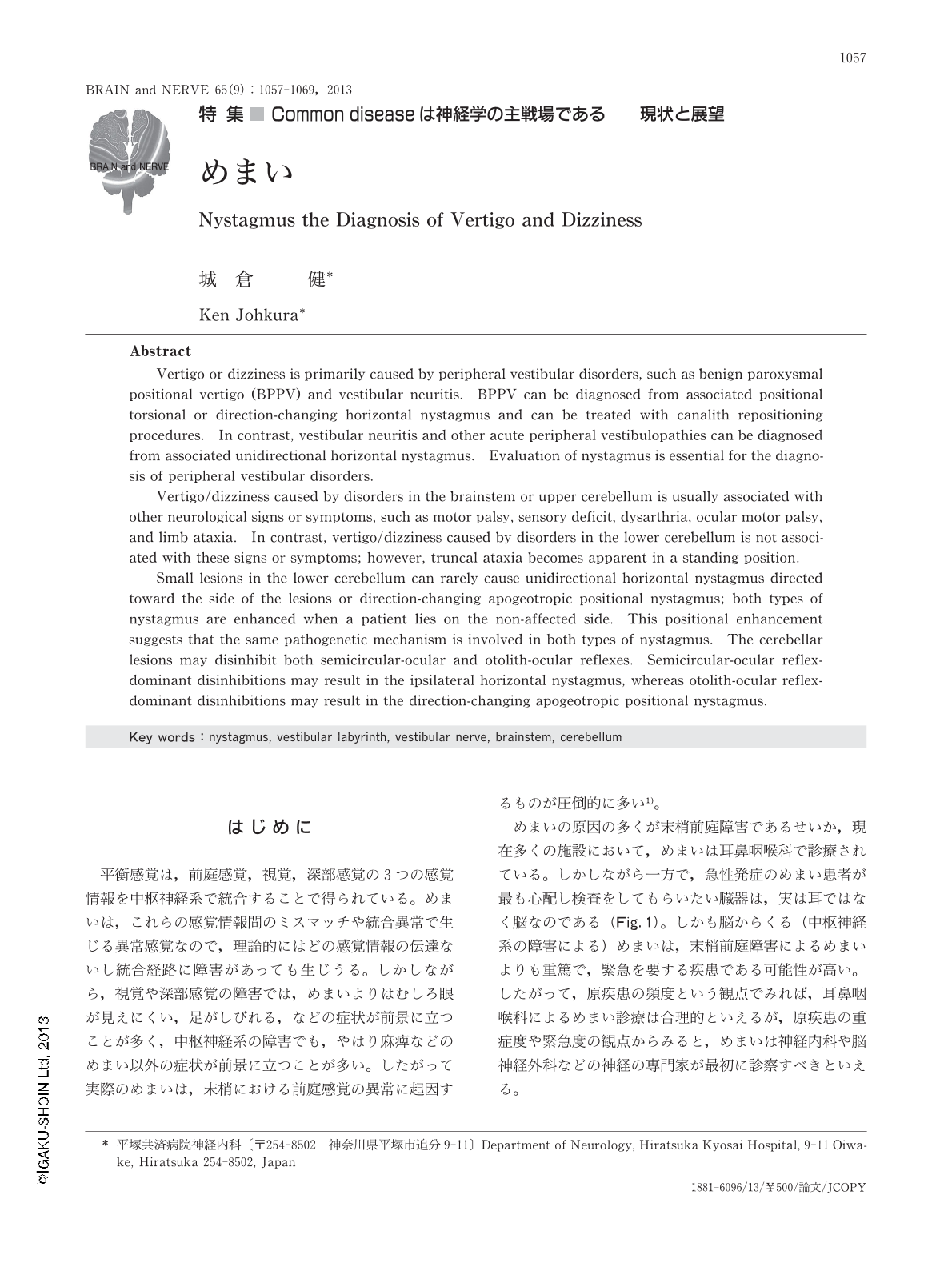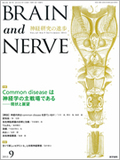Japanese
English
- 有料閲覧
- Abstract 文献概要
- 1ページ目 Look Inside
- 参考文献 Reference
はじめに
平衡感覚は,前庭感覚,視覚,深部感覚の3つの感覚情報を中枢神経系で統合することで得られている。めまいは,これらの感覚情報間のミスマッチや統合異常で生じる異常感覚なので,理論的にはどの感覚情報の伝達ないし統合経路に障害があっても生じうる。しかしながら,視覚や深部感覚の障害では,めまいよりはむしろ眼が見えにくい,足がしびれる,などの症状が前景に立つことが多く,中枢神経系の障害でも,やはり麻痺などのめまい以外の症状が前景に立つことが多い。したがって実際のめまいは,末梢における前庭感覚の異常に起因するものが圧倒的に多い1)。
めまいの原因の多くが末梢前庭障害であるせいか,現在多くの施設において,めまいは耳鼻咽喉科で診療されている。しかしながら一方で,急性発症のめまい患者が最も心配し検査をしてもらいたい臓器は,実は耳ではなく脳なのである(Fig.1)。しかも脳からくる(中枢神経系の障害による)めまいは,末梢前庭障害によるめまいよりも重篤で,緊急を要する疾患である可能性が高い。したがって,原疾患の頻度という観点でみれば,耳鼻咽喉科によるめまい診療は合理的といえるが,原疾患の重症度や緊急度の観点からみると,めまいは神経内科や脳神経外科などの神経の専門家が最初に診察すべきといえる。
今回,国内外におけるめまい診療の現況と展望についてレビューするよう依頼されたが,上記のような現状を踏まえると,多くの神経内科医がめまい診療に必要となる正確な知識を持つことこそが重要と考える。本稿では,めまいの原疾患を末梢性と中枢性に分けて概説し,その後,原疾患の特徴と頻度を踏まえた効率的なめまいの鑑別法を紹介する。
Abstract
Vertigo or dizziness is primarily caused by peripheral vestibular disorders, such as benign paroxysmal positional vertigo (BPPV) and vestibular neuritis. BPPV can be diagnosed from associated positional torsional or direction-changing horizontal nystagmus and can be treated with canalith repositioning procedures. In contrast, vestibular neuritis and other acute peripheral vestibulopathies can be diagnosed from associated unidirectional horizontal nystagmus. Evaluation of nystagmus is essential for the diagnosis of peripheral vestibular disorders.
Vertigo/dizziness caused by disorders in the brainstem or upper cerebellum is usually associated with other neurological signs or symptoms, such as motor palsy, sensory deficit, dysarthria, ocular motor palsy, and limb ataxia. In contrast, vertigo/dizziness caused by disorders in the lower cerebellum is not associated with these signs or symptoms; however, truncal ataxia becomes apparent in a standing position.
Small lesions in the lower cerebellum can rarely cause unidirectional horizontal nystagmus directed toward the side of the lesions or direction-changing apogeotropic positional nystagmus; both types of nystagmus are enhanced when a patient lies on the non-affected side. This positional enhancement suggests that the same pathogenetic mechanism is involved in both types of nystagmus. The cerebellar lesions may disinhibit both semicircular-ocular and otolith-ocular reflexes. Semicircular-ocular reflex-dominant disinhibitions may result in the ipsilateral horizontal nystagmus, whereas otolith-ocular reflex-dominant disinhibitions may result in the direction-changing apogeotropic positional nystagmus.

Copyright © 2013, Igaku-Shoin Ltd. All rights reserved.


